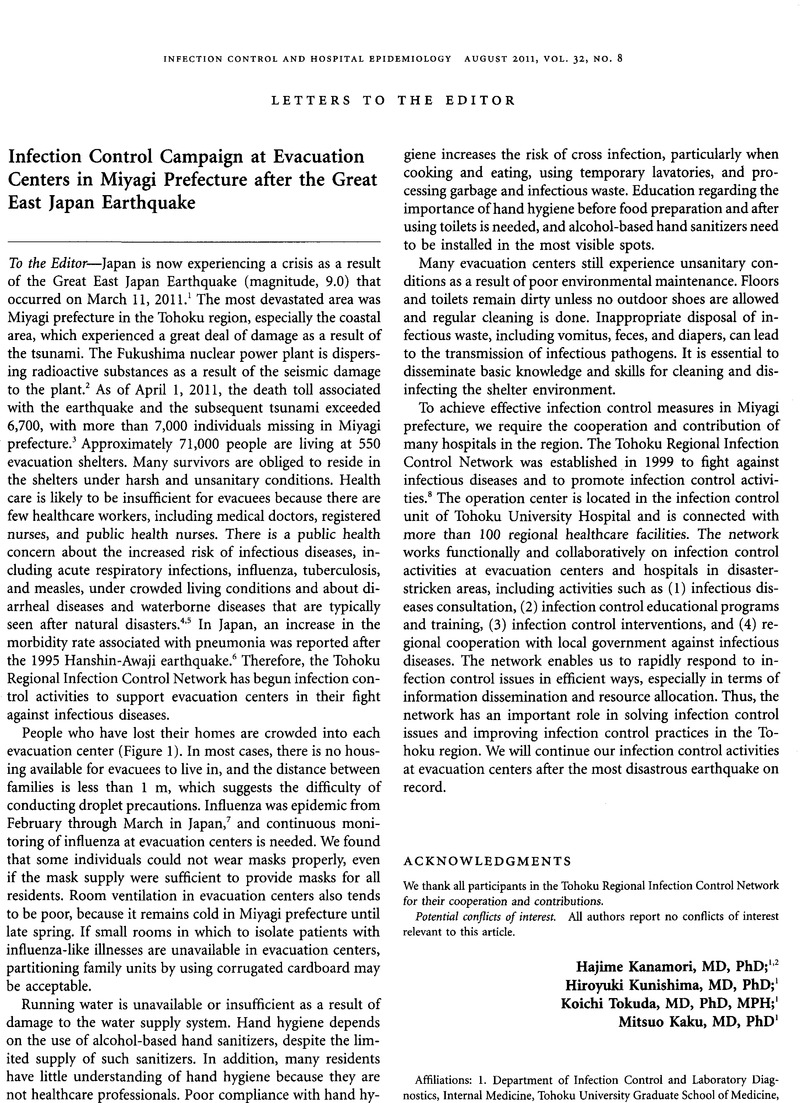Crossref Citations
This article has been cited by the following publications. This list is generated based on data provided by Crossref.
Kunishima, Hiroyuki
and
Kaku, Mitsuo
2012.
1. Infectious Diseases Post Great East Japan Earthquake.
Nihon Naika Gakkai Zasshi,
Vol. 101,
Issue. 11,
p.
3090.
Iwata, Kentaro
Ohji, Goh
Oka, Hideaki
Takayama, Yoshihiro
Aoyagi, Tetsuji
Gu, Yoshiaki
Hatta, Masumitsu
Tokuda, Koichi
and
Kaku, Mitsuo
2012.
Communicable Diseases After the Disasters: with the Special Reference to the Great East Japan Earthquake.
Journal of Disaster Research,
Vol. 7,
Issue. 6,
p.
746.
Takahashi, Takashi
Goto, Mieko
Yoshida, Haruno
Sumino, Hiroyuki
and
Matsui, Hidenori
2012.
Infectious Diseases after the 2011 Great East Japan Earthquake.
Journal of Experimental & Clinical Medicine,
Vol. 4,
Issue. 1,
p.
20.
Yambe, Tomoyuki
Shibata, Muneichi
Sumiyoshi, Taketada
Mibiki, Yoshiaki
Osawa, Noboru
Katahira, Yoshiaki
Yambe, Minoru
Tabayashi, Kou‐ichi
Yamashina, Masanori
Sato, Eiji
Sato, Shinichi
Yagi, Tetsuo
Watanabe, Makoto
Akinno, Yoshihira
Munakata, Masanori
Owada, Naoki
Akiyama, Masatoshi
Saiki, Yoshikatsu
Sugita, Norihiro
and
Yoshizawa, Makoto
2012.
Medical Responses Following the Sendai Quake (East Japan Earthquake, March 11, 2011).
Artificial Organs,
Vol. 36,
Issue. 8,
p.
760.
Kanamori, Hajime
Aso, Noboru
Tadano, Satoko
Saito, Miyoko
Saito, Hiroo
Uchiyama, Bine
Ishibashi, Noriomi
Inomata, Shinya
Endo, Shiro
Aoyagi, Tetsuji
Hatta, Masumitsu
Yamada, Mitsuhiro
Gu, Yoshiaki
Tokuda, Koichi
Yano, Hisakazu
Kunishima, Hiroyuki
Hirakata, Yoichi
Saijyo, Takao
Kitagawa, Miho
and
Kaku, Mitsuo
2013.
Tuberculosis Exposure among Evacuees at a Shelter after Earthquake, Japan, 2011.
Emerging Infectious Diseases,
Vol. 19,
Issue. 5,
p.
799.
Kaku, Mitsuo
2014.
3. Medical Disease Learned from the Great East Japan Earthquake-Feature, Treatment and Prevention-; 5) Total Management for Infectious Diseases.
Nihon Naika Gakkai Zasshi,
Vol. 103,
Issue. 3,
p.
572.
Kanamori, Hajime
Kimura, Ryo
Weber, David J.
Uchiyama, Bine
Hirakata, Yoichi
Aso, Noboru
Kiryu, Koji
and
Kaku, Mitsuo
2014.
Lessons learned from earthquake-related tuberculosis exposures in a community shelter, Japan, 2011.
American Journal of Infection Control,
Vol. 42,
Issue. 3,
p.
246.
Santos, Joost R.
Herrera, Lucia Castro
Yu, Krista Danielle S.
Pagsuyoin, Sheree Ann T.
and
Tan, Raymond R.
2014.
State of the Art in Risk Analysis of Workforce Criticality Influencing Disaster Preparedness for Interdependent Systems.
Risk Analysis,
Vol. 34,
Issue. 6,
p.
1056.
Tokuda, Koichi
Kunishima, Hiroyuki
Gu, Yoshiaki
Endo, Shiro
Hatta, Masumitsu
Kanamori, Hajime
Aoyagi, Tetsuji
Ishibashi, Noriomi
Inomata, Shinya
Yano, Hisakazu
Kitagawa, Miho
and
Kaku, Mitsuo
2014.
A survey conducted immediately after the 2011 Great East Japan Earthquake: Evaluation of infectious risks associated with sanitary conditions in evacuation centers.
Journal of Infection and Chemotherapy,
Vol. 20,
Issue. 8,
p.
498.
Yokoyama, Yoshie
Hirano, Kayoko
Sato, Mari
Abe, Akiko
Uebayashi, Mihoko
Kishi, Emiko
Sato, Mutsuko
Kuroda, Yuuko
Nakaita, Ikumi
and
Fukushima, Fujio
2014.
Activities and Health Status of Dispatched Public Health Nurses after the Great East Japan Earthquake.
Public Health Nursing,
Vol. 31,
Issue. 6,
p.
537.
Tsuboi, Akito
2015.
Dental support for the victims of the large-scale disaster.
Annals of Japan Prosthodontic Society,
Vol. 7,
Issue. 2,
p.
117.
Shackelford, Brandie Banner
Cronk, Ryan
Behnke, Nikki
Cooper, Brittany
Tu, Raymond
D'Souza, Mabel
Bartram, Jamie
Schweitzer, Ryan
and
Jaff, Dilshad
2020.
Environmental health in forced displacement: A systematic scoping review of the emergency phase.
Science of The Total Environment,
Vol. 714,
Issue. ,
p.
136553.
Zhao, Bo
Kong, Fanlei
Aung, Myo Nyein
Yuasa, Motoyuki
and
Nam, Eun Woo
2020.
Novel Coronavirus (COVID-19) Knowledge, Precaution Practice, and Associated Depression Symptoms among University Students in Korea, China, and Japan.
International Journal of Environmental Research and Public Health,
Vol. 17,
Issue. 18,
p.
6671.
Yasui, Arisa
and
Numada, Muneyoshi
2021.
A Report of the Questionnaire Survey on Awareness of COVID-19 and Shelters.
Journal of Disaster Research,
Vol. 16,
Issue. 4,
p.
747.
Yasui, Arisa
and
Numada, Muneyoshi
2021.
Science-Based Approaches to Respond to COVID and Other Public Health Threats.
Sawano, T
Ito, N
Ozaki, A
Nishikawa, Y
Nonaka, S
Kobashi, Y
Higuchi, A
and
Tsubokura, M
2021.
Evacuation of residents in a natural disaster during the COVID-19 era.
QJM: An International Journal of Medicine,
Vol. 114,
Issue. 7,
p.
445.
Kanamori, Hajime
Baba, Hiroaki
and
Weber, David J.
2021.
Rethinking One Health approach in the challenging era of COVID-19 pandemic and natural disasters.
Infection Ecology & Epidemiology,
Vol. 11,
Issue. 1,
Kumar, Atul
2022.
Management of Animals in Disasters.
p.
245.
Tokumaru, Osamu
Fujita, Masanori
Nagai, Saeko
Minamikawa, Yoko
and
Kumatani, Junnosuke
2022.
Medical Problems and Concerns with Temporary Evacuation Shelters after Great Earthquake Disasters in Japan: A Systematic Review.
Disaster Medicine and Public Health Preparedness,
Vol. 16,
Issue. 4,
p.
1645.



